October 12th, 2018
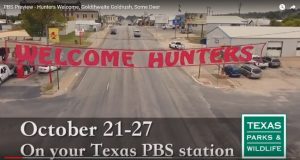
TPW TV- Opening weekend of hunting season in small town Texas.
This is Passport to Texas
The week of October 21, Texas Parks and Wildlife TV series captures the excitement of deer season opening weekend; series producer, Don Cash.
We sent a lot of producers to Goldthwaite, Texas for the opening weekend of deer season. We follow a young deer hunter who lives in Goldthwaite; we spend some time at a processing facility–people bringing their deer in. We take a look at some of the businesses, restaurants and different places in Goldthwaite that look forward to the opening weekend of deer season because it’s good for them financially. So, this is
something we’ve talked about for years–being able to show people the economic impact of hunting. I think it’s going to be kind of interesting, actually.
Cash said, his team could not have achieved this feat without the kind and enthusiastic support of the people of Goldthwaite.
A gentleman named Warren Blesh who’s the President of the Simms Creek Wildlife Management Association went out of his way, and the people of Goldthwaite went out of their way, to help us find people to tell their stories. And really cleared the way for us to come in and run wild with our cameras. And, we showed up with our cameras, and people were pretty excited about us coming in to tell the story of what goes on in a small town in Texas when hunting season rolls around.
See this show the week of October 21 on PBS; check your local listings.
The Wildlife restoration program supports our series.
For Texas Parks and Wildlife…I’m Cecilia Nasti.
Posted in Hunting, TPWD TV, white-tailed deer | Comments Off on TPW TV — Hunters Welcome
October 11th, 2018
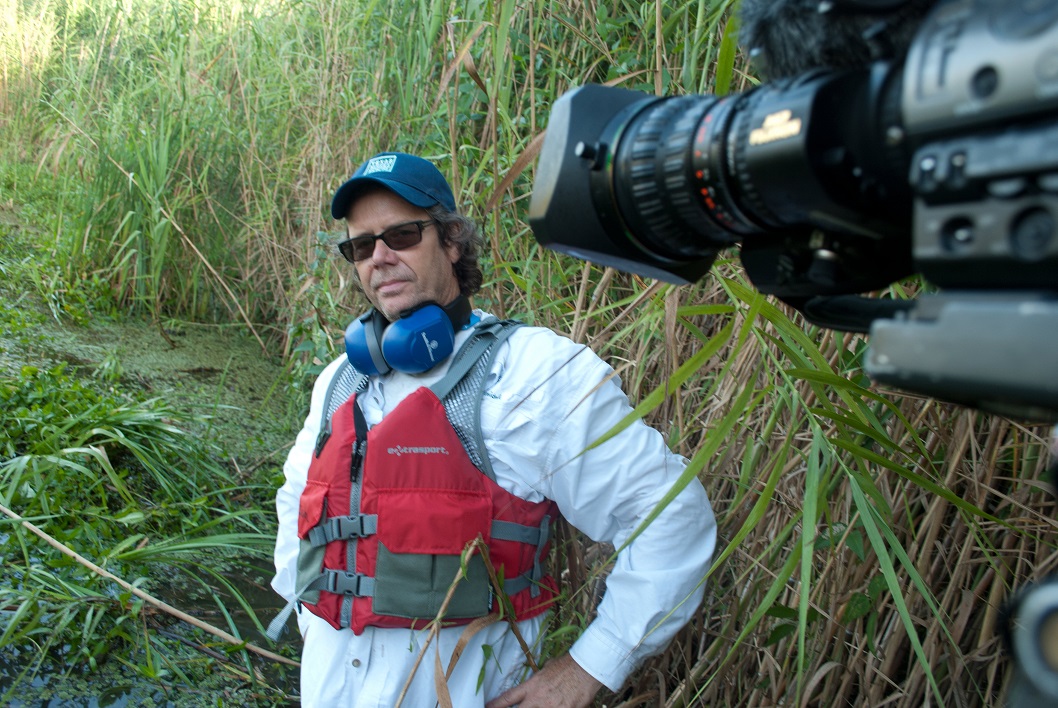
TPWD TV Series producer, Don Cash.
This is Passport to Texas
Texas Parks and Wildlife is one of the few state natural resource agencies that still produces a weekly television program. It’s been on the air 33 years.
And the reason we do it is because we have a very good message to let Texans know about.
Series producer, Don Cash.
We’re the folks who help take care of deer and birds and water and parks and all kinds of things. And like I always say: if we don’t tell people what we do here, no one else is going to do it for us.
The Texas Parks and Wildlife TV series, which airs on PBS and other outlets, spreads the message of conservation and recreation in Texas. The new season is shaping up to be one of the best.
Our new season begins the week of October 14th. You know, we’ve got a lot of new stuff. This year, we’re going to look at green jays, black-capped vireos, paddlefish, prairie dogs, chimney swifts. Coyotes. We’ve got stories coming on paddling the San Antonio River. What’s up with Bastrop State park after the fires. We’re going to go diving the Kraken. Take a trip to the Austin library to look at their very green roof. We’re going to look at the oyster industry in Texas, too.
But there is one show this season that took more planning, coordination and cooperation than any other produced before it.
We are devoting an entire show to what happens on the opening weekend of deer season in Texas.
Details coming up on tomorrow’s show.
For Texas Parks and Wildlife…I’m Cecilia Nasti.
Posted in TPWD TV | Comments Off on TPW TV — Looking Ahead to the New Season
October 10th, 2018
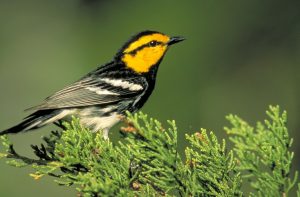
Golden-Cheeked Warbler
This is Passport to Texas
Mist-nets are tools used by ornithologists and biologists that allow them to trap birds, to collect information. The data helps them to understand and manage species.
The net’s mesh is so fine that it doesn’t even register as a barrier, and so birds end up flying directly into it. While they become entangled, they rarely sustain injuries.
Once entrapped, biologists take special care to gently extract their feathery captives, and waste no time identifying the species, its sex and its estimated age. Biologists do not handle the birds more than is necessary.
When researchers employ mist-nets, it’s often so they can trap birds for banding. They may target threatened and endangered birds like the golden-cheeked warbler. The hope is that at some future time, another scientist will capture the previously banded bird and gather more data, such as where it came from and where it’s traveled along its life’s journey.
Mist-netting by Texas Parks and Wildlife biologists takes place throughout the year on wildlife management areas and in some state parks. From time to time, the bird-loving public is invited to participate in the process.
Keep an eagle eye on the calendar section of the Texas Parks and Wildlife website for these and other opportunities to join biologists in the field.
The Wildlife Restoration program supports our series, and provides funding for the operations and management of Texas’ Wildlife Management Areas.
For Texas Parks and Wildlife…I’m Cecilia Nasti.
Posted in Birding, Research, Wildlife and Sport Fish Restoration Program | Comments Off on Netting Songbirds for Research
October 9th, 2018
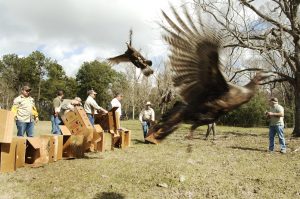
Turkey release.
This is Passport to Texas
In the 1930s, it became evident that certain game animals were in decline due, in part, to unregulated overharvest.
In 1937, the Federal Government passed the Pittman-Robertson Act, thus creating an excise tax on the purchase of ammunition and hunting equipment.
Today, millions of dollars of funds generated by these taxes are used to manage and restore both game and non-game species.
One of Texas’ ongoing restoration projects involves the eastern wild turkey. Historically, the species occupied nearly 30 million acres in eastern Texas, but unregulated overharvest of both turkeys and timber led to their near extinction from that region. In 1942 there were fewer than 100 eastern wild turkeys remaining.
From 1979 to 2003, Texas parks and Wildlife Department translocated an estimated 7,000 wild-captured birds into 58 counties in central and east Texas, eventually seeing the population climb to 10,000–which is slow progress.
In 2014 the agency began a “Super Stocking” initiative, translocating 80 eastern turkey at a time at selected sites. Production and survival of the birds has vastly improved with this method. Thus, creating a brighter future for this big bird in Texas.
The Wildlife Restoration Program supports our series and provides support for the translocation and surveying of eastern wild turkey.
For Texas Parks and Wildlife…I’m Cecilia Nasti
Posted in Conservation, Research, wild turkey, Wildlife and Sport Fish Restoration Program | Comments Off on Talkin’ Turkey via Wildlife Restoration
October 8th, 2018
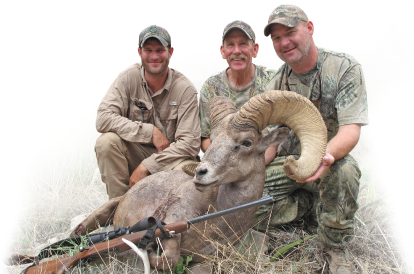
Big Time Texas Hunts Grand Slam
This is Passport to Texas
Hunters hoping for a chance at premium guided hunt packages through the Texas Parks and Wildlife Department’s Big Time Texas Hunts program have until midnight Monday, Oct. 15 to enter. That’s the deadline for the opportunity to be selected for these top shelf hunting adventures.
Big Time Texas Hunts provide opportunities to win one or more of nine premium guided hunt packages with food and lodging provided, as well as taxidermy in some cases.
The crown jewel of the program is the Texas Grand Slam hunt package, which includes four separate hunts for Texas’ most prized big game animals — the desert bighorn sheep, white-tailed deer, mule deer and pronghorn.
In addition to the Grand Slam, there are several quality deer hunting packages available, as well as opportunities to pursue alligator, waterfowl, upland game birds, wild hog and exotics. New to the program this year is the Nilgai Antelope Safari in South Texas.
Enter online through October 15 at the Texas Parks and Wildlife website; it’s $9 per entry. You’ll pay a $5 online administrative fee, but it allows unlimited entries in a single transaction.
Proceeds from Big Time Texas Hunts support public hunting opportunities and wildlife habitat conservation in Texas.
For Texas Parks and Wildlife…I’m Cecilia Nasti.
Posted in Big Time Texas Hunts, Conservation, Events, Hunting | Comments Off on Deadline for Big Time Texas Hunts Nears







 Passport to Texas is a
Passport to Texas is a  Passport to Texas is made available by:
Passport to Texas is made available by: